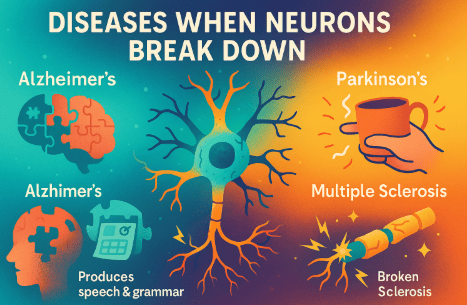
Quick Recap of Last Lesson
In Lesson 3, we learned why the brain is such a hungry organ, eating 20% of our energy even though it’s only 2% of our weight. We saw how neurons depend on glucose (sugar) and oxygen to make ATP, the energy “coin” of life.
We discovered how energy powers the sodium–potassium pump, keeps action potentials firing, and recycles neurotransmitters.
But what happens when this finely tuned system gets disrupted? Today’s lesson is about brain diseases, especially those where neurons don’t get enough fuel, misfire, or even die.
Step 1: The Fragile Powerhouse ⚡💔
The brain is powerful, but also fragile. Neurons are some of the most demanding cells in your body:
-
They need constant oxygen and glucose.
-
They can’t store much energy.
-
They don’t divide and replace themselves easily.
👉 This means that when something goes wrong—lack of oxygen, too much electrical activity, or toxic buildup—neurons are some of the first cells to suffer.
Step 2: Stroke – When Blood Stops Flowing 🚫💉
A stroke happens when blood supply to part of the brain is blocked (ischemic stroke) or when a blood vessel bursts (hemorrhagic stroke).
Without oxygen and glucose, neurons die within minutes. This is why stroke symptoms (like sudden weakness, slurred speech, or vision loss) appear so quickly.
Think of it like a city losing power. Traffic lights go dark, trains stop, and chaos spreads. The brain’s networks also collapse without fuel.
Key idea: Time is crucial. The faster doctors restore blood flow, the more neurons can be saved.
Step 3: Epilepsy – Storms in the Brain ⛈️⚡
In epilepsy, neurons fire too much and too synchronously. Instead of smooth, balanced firing, you get runaway electrical storms.
👉 A seizure is the outward effect of this storm—sudden movements, loss of awareness, or even convulsions.
It’s like a city where every house turns on every light, TV, and microwave at once—the power grid overloads.
Treatments often involve drugs that increase GABA (the brain’s calming neurotransmitter) or decrease glutamate (the excitatory one), restoring balance.
Step 4: Alzheimer’s Disease – Memory on Fire 🧩🔥
Alzheimer’s disease is a neurodegenerative disease, meaning neurons slowly die over years.
Two main problems happen:
-
Amyloid plaques – clumps of misfolded proteins that build up between neurons.
-
Tau tangles – twisted proteins inside neurons that disrupt transport systems.
Together, these cause neurons in memory areas (like the hippocampus) to weaken and die.
👉 This explains why early Alzheimer’s signs are memory loss, confusion, and difficulty learning new things.
It’s like a library where books are being destroyed and the shelves are collapsing. The “memory archives” shrink.
Step 5: Parkinson’s Disease – Movement in Slow Motion 🕺🐢
In Parkinson’s disease, neurons in a small brain area called the substantia nigra die. These neurons normally release dopamine, the messenger that controls smooth movement.
With less dopamine:
-
Movements become shaky (tremors).
-
Muscles stiffen.
-
Walking slows.
It’s like an orchestra losing its conductor—the music (movement) becomes uneven and hard to control.
Medicines like L-DOPA can help, because the brain can turn it into dopamine. But they don’t stop neuron loss.
Step 6: Multiple Sclerosis – When Myelin Burns Away 🧤🔥
In multiple sclerosis (MS), the immune system mistakenly attacks myelin, the fatty coating that speeds up signals.
When myelin is damaged:
-
Signals slow down or get lost.
-
Symptoms can include numbness, weakness, or trouble seeing.
Imagine a phone wire with its plastic covering stripped off. Calls get scrambled or drop completely.
Multiple sclerosis shows how important insulation is for the brain’s “electric cables.”
Step 7: Inflammation – When the Brain Is Literally on Fire 🔥🧠
Sometimes, infections (like meningitis or encephalitis) cause inflammation—the brain’s immune response.
Inflammation can help fight germs, but too much damages neurons. This is why fever, confusion, or seizures can occur with brain infections.
It’s like firefighters trying to put out a fire but accidentally flooding and destroying the house.
Step 8: Hope in Healing 🌱
Though many brain diseases are devastating, neuroscience is finding ways forward:
-
Clot-busting drugs for strokes.
-
Anti-seizure medicines for epilepsy.
-
New drugs and lifestyle approaches for Alzheimer’s.
-
Brain implants and dopamine therapies for Parkinson’s.
-
Immunotherapies for multiple sclerosis.
The brain is fragile—but also adaptable. Neuroplasticity (the brain’s ability to rewire) offers hope that even damaged brains can regain function.
Final Recap 📝
In this lesson, we saw what happens when neurons break down.
Strokes cut off blood and oxygen, epilepsy causes electrical storms, Alzheimer’s destroys memory, Parkinson’s disrupts movement, and multiple sclerosis strips insulation from neurons.
Inflammation can also damage the brain when the immune system goes into overdrive.
But science offers hope: medicines, therapies, and the brain’s own adaptability may one day allow us to heal what once seemed impossible.
Next time, we’ll explore how drugs and chemicals hack the brain—sometimes for healing, sometimes for harm. 💊🧠